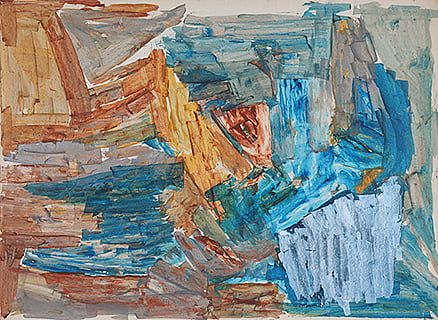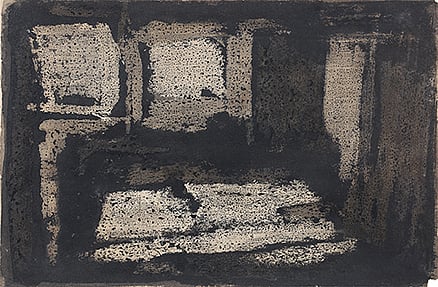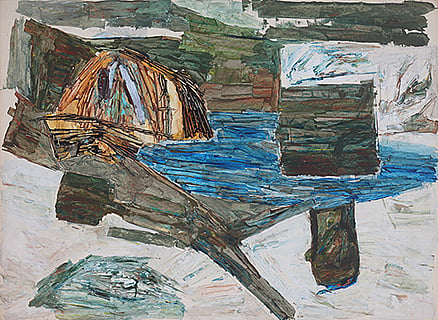The monastic quest of Ram Kumar
Ram Kumar was a prolific painter, traveller & a passionate writer, with a creative career spanning over seven decades. Ram Kumar’s books are still a prized possession of literature

India’s leading modernist artist Ram Kumar’s oeuvre of art is replete with a serene quietude and monastic world of a deep aesthetic vision. The abstract landscape painter seems to have inherited his aesthetic ideals from the early 20th century modernisms of Paris, London and Vienna. It left a deep mark on his artistic approach.
Ram Kumar was a prolific painter, traveller and a passionate writer, with a creative career spanning over seven decades. He was an accidental artist since he gave up his job at a bank to learn art under Sailoz Mukherjee at Sharda Ukil School of Art in 1948. Born into a family in Shimla in 1924, he initially pursued his MA in Economics from St. Stephens’ College in Delhi. However, soon after his introduction to art, in 1949 he borrowed a small amount of money from his father and travelled to Paris to study art with the support of a French Embassy Scholarship. In Paris, he studied under Cubist painter Fernand Leger and sculptor and figurative painter Andre’ Lhote. He was also to join the pacifist movement and the Communist Party in Paris. In these early years, he produced figurative paintings. He said, “My figuratives were more of the urban predicament, fuelled by socialist realism.” While in Paris, he met SH Raza and stayed with him for a short period during which urban cityscape begin to appear as backdrop to his figures.
He chose to return to India in 1952 and root his art in his own country. His training in Paris along with his association with the Mumbai based Progressive Artist Group and with the Delhi Shilpi Chakra, provided him the necessary professional alignments which enabled him to sharpen his artistic tools. In 1960 he travelled to Varanasi with MF Hussain, and this marked a turning point in his life and this magical city would remain his muse for the rest of his life. From here on abstract landscape began his main subject, rendered time and again as an amalgamation of colours and textures . Ram Kumar’s landscape often straddle the boundaries between abstraction and naturalism, quoting both but succumbing to neither.
The ghat of the only world: Banares
The mysticism and spirituality surrounding the landscape of Banares became an obsession for him. “In the solitary, silent mountains of Shimla, I became familiar for the first time with the name of Kashi from the novels of Sarat Chandra when I was a small school boy. Somehow this fascination was related to the old age, widows, the river Ganga, her ghats, death and birth and paean of a pilgrim. At that time I had never dreamt that it would became so significant to me both as an artist as well as a human being, that its shadow would linger for such a long time,” he wrote in one of his greatest works The Boats (1968). According to the late Richard Bartholomew, Banares had a profound effect on his paintings and it marked the beginning of a long & rewarding journey into the melancholic work of a deeply reflective artist. Two bodies of work stand out in this phase—the ‘Banares Series’ and ‘Sad Town’ and each is distinctive for the visual distillation of complex symbolism. Writing about the ‘Banares Series’ Bartholomew noted in a major essay on the artist about how Ram kumar captured the essentials of the eternal city. “Banares was distantly and almost indistinctly as a mirage, a wedge of intricate structure between expanses of what now appeared to be water and sky. The city appeared to be emanation.” What is distinctive about the Ram Kumar’s rendition of Banares is the reduction of the holy city with all its temproral and spiritual connections to a formal architectonic visual frame, where the sacred is leavened with the profane and the figurative elements lead to a contemporary abstraction.
Besides being a prolific painter, Ram Kumar was also a leading mainstream Hindi writer of the 60s and 70s. Elder brother of the great Nirmal Verma, Ram Kumar’s books are still a prized possession of literature. First came, ‘The Sea and the other strories’ (1968), then ‘Shilalekh tatha anya kahaniyaan ‘ (1995), followed by ‘The Face and other stories’ (2004) and ‘Europe Ke Sketch’ (2007).
A recipient of the Padma Bhushan, Ram Kumar , the artist par excellence , who passed away in Delhi on April 14 (Saturday) will long be remembered for his substantive contribution to contemporary art – since the early 1950s to as recently as December 2016 when a major retrospective of his work was held in Delhi at The Saffron Art Gallery . When asked if his short stories had any bearing on his paintings ,he stated emphatically that each had its own place. Yet both the short stories & the paintings reflect the humble, humdrum lives of ordinary people , with the pitfalls they face & the resilience they demonstrate –myriad lives that ultimately enmesh to provide , as it were ,the scaffolding for the India of today. With his passing away at the age of 94, we have lost one of the last members of the epic generation—who believed in the endless generation of life against death . “Ram Kumar’s life, as also his art, was a Sadhana—an effort where the result often forgotten or the result was not what mattered, it was the effort that did,” thus remembers Arun Vadhera, mourning the loss of a mentor & passionate supporter. “Ram Kumar has been a part of the birth and growth of the Vadhera Art Gallery that held over 22 solo exhibitions of the great artist over the years and it was with ‘Ram Kumar—A Journey Within’ in 1996 the gallery started its foray into publication,” said Vadehra. Thus he paid his homage to the great master artist.
Ram Kumar’s unfathomable world of art and his vision will remain and stay for long as an observation he made in the course of an interview is worth remembering. “When one is young & beginning, ones’ work is dominated by content, by ideas but as one grows older, one turns to the language of painting itself. I have grown detached. I want to find the same peace that the mystics found.” Lead kindly light, may the ever—searching--ever wandering soul attain peace and salvation. Amen!
Follow us on: Facebook, Twitter, Google News, Instagram
Join our official telegram channel (@nationalherald) and stay updated with the latest headlines
- Shimla
- Padma Bhushan
- Sarat Chandra
- Ram Kumar
- painter
- traveller
- passionate writer
- abstract landscape painter
- Sailoz Mukherjee
- Sharda Ukil School of Art
- French Embassy Scholarship
- Progressive Artist Group
- landscape of Banares
- Delhi Shilpi Chakra
- Shilalekh tatha anya kahaniyaan
- Richard Bartholomew
- The Boats
- Banares Series
- Europe Ke Sketch
- Vadhera Art Gallery



